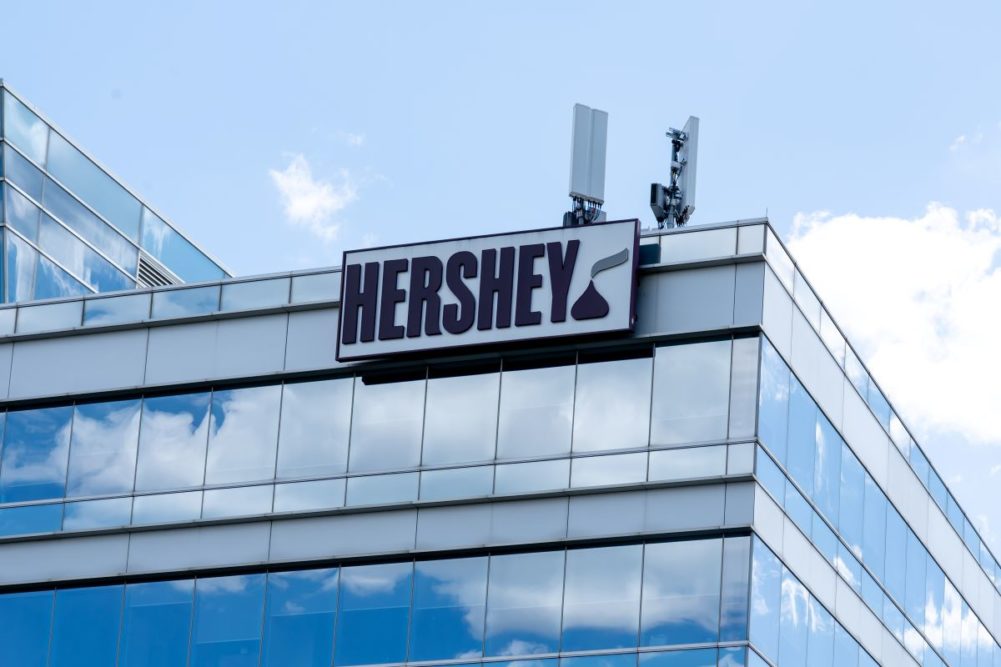HERSHEY, PA. — The Hershey Co. overcame persistent supply chain disruptions to deliver double-digit sales growth across each of its business segments in the recent quarter. Management has raised its full-year outlook to reflect continued strong demand and increased prices across its portfolio that are expected to more than offset higher costs and elevated advertising and merchandising levels in the months ahead.
Net income for the second quarter ended July 3 was $315.6 million, equal to $1.53 per share, up from $301.2 million, or $1.45 per share, in the prior-year period. Excluding unusual items including derivative mark-to-market losses, business realignment activities, acquisition activities and other miscellaneous losses, adjusted net income was $372.4 million, up from adjusted net income of $305.8 million in the year-ago quarter.
Net sales totaled $2.4 billion, up 19% from $2 billion the year before. Stripping out the benefit of last year’s Dot’s, Pretzels and Lily’s acquisitions, as well as currency impacts, Hershey’s organic net sales grew 14% driven by pricing and volume gains.
“Second-quarter growth was broad-based, with each segment delivering double-digit sales growth, resulting in strong earnings per share,” Michele G. Buck, president and chief executive officer, said in pre-recorded remarks ahead of a July 28 earnings call. “Organic net sales growth of 14% was driven by both price and volume gains while acquisitions contributed another 5 points of growth. Despite persistent, broad-based supply chain disruptions, our teams were able to increase production output and inventory levels during the quarter. This not only bolstered sales growth, but also drove improvements in marketplace share performance and will enable us to more fully activate our portfolio in the second half of the year.”
While inflation is pressuring many Americans, consumers are still purchasing branded snacks and candy rather than lower-priced private label items in those categories, Ms. Buck said.
“I think across snacking, what we tend to see is consumers very much like their brands,” Ms. Buck said. “So if you look across total food, as budgets are tighter, certainly, private label brands have grown share versus with across snacking, private label has not and consumers tend to like their brands.”
In the second quarter, North America Confectionery segment income increased 12% to $618.9 million behind pricing and volume gains that were partially offset by higher supply chain costs, acquisitions costs and increased trade show and travel expenses versus the prior year. The segment’s net sales advanced 13% to $1.9 billion versus the same period last year. Candy, mint and gum sales in the United States increased 5%, driven by steady consumer demand and price increases.
“As we look to the second half, we expect our higher inventory levels and increased advertising and merchandising to drive strong everyday sales and share performance,” Ms. Buck said. “Chocolate media spending is projected to grow double digits in the second half, and quality merchandising is also expected to increase.
“Seasonal consumer engagement is expected to remain high, and we expect high single-digit sales growth for both our Halloween and holiday seasons. Despite this strong growth, we will not be able to fully meet consumer demand due to capacity constraints.
“Given many of our everyday and seasonal products are made on the same line, we have needed to balance production over the past several months to improve everyday on-shelf availability and build seasonal inventory at the same time. While this will likely result in second-half seasonal share pressures, we expect our everyday share trends to remain strong behind higher inventory levels and more advertising and merchandising.”
North America Salty Snacks segment income jumped 44% to $37.4 million, as pricing gains and higher volumes offset unfavorable mix, acquisition-related costs and higher supply chain costs. Segment net sales soared 100% to $256.3 million, largely driven by the Dot’s and Pretzels acquisitions, as well as, to a lesser extent, net price realization.
“Our salty snacks brands continue to deliver tremendous growth and share gains,” Ms. Buck said. “Over the past 12 weeks, SkinnyPop retail sales grew 17% and share of the ready-to-eat popcorn segment increased 130 basis points to 24%. Growth is led by higher household penetration and stable buy rates as new pack sizes have enabled us to capture incremental occasions.
“Pirate’s Booty also continues to gain households via distribution gains, while velocities remain strong resulting in 32% retail sales growth in the latest 12-week period. And Dot’s Pretzels growth continues to significantly outpace the pretzel category, with 45% retail sales growth and 340 basis points of share gains over the past three months.
“To support this sustained, elevated growth, we continue to advance our strategic planning to optimize our salty snacks supply chain for additional capacity and margin efficiencies.”
Hershey’s International segment profit was $30.7 million, up $3.1 million from the year-ago period, reflecting volume gains and net price realization partially offset by higher supply chain and logistics costs, advertising investment, salary and benefit inflation and increased travel expenses. International segment net sales increased 21% to $207.2 million from the year-ago quarter.
“Consumer demand has remained strong across markets, with distribution and innovation driving double digit growth in each market during the quarter,” Ms. Buck said, highlighting Hershey’s Kisses in India and better-for-you innovation in Mexico as top performers.
For the full year, executives now expect net sales growth of 12% to 14% for the year, up from the previous guidance of 10% to 12%. Reported earnings per share growth is expected to be in the range of 9% to 12%, compared to the previous guidance of 8% to 11%.
Shares of the Hershey Co. trading on the New York Stock Exchange ticked up to $224.27 on July 28, an increase of 2.8% from the previous close of $218.23.




